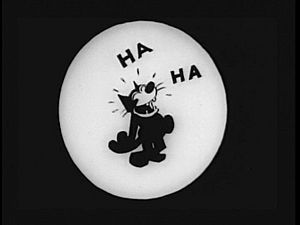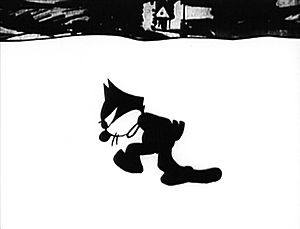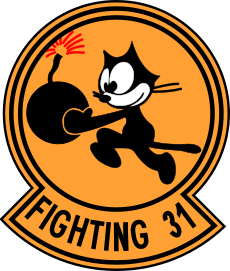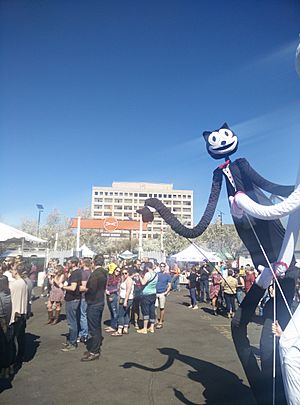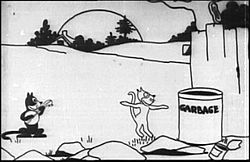Felix the Cat facts for kids
Quick facts for kids Felix the Cat |
|
|---|---|

Felix in his current design
|
|
| First appearance | Feline Follies (1919) |
| Created by | Pat Sullivan Otto Messmer |
| Voiced by | English Harry Edison (1929–1930) Walter Tetley (1936) Jack Mercer (1959–1962) Ken Roberts (1959) David Kolin (1988) Jim Pike (1990) Thom Adcox-Hernandez (1995) Charlie Adler (1996) Don Oriolo (2000–2001) Denise Nejame (2000–2001; Baby) Dave Coulier (2004) Lani Minella (2010) Japanese Toshihiko Seki (2000–2001) Yumi Tōma (2000–2001; Baby) |
| Information | |
| Species | Cat |
| Gender | Male |
| Family | Inky and Winky (nephews) |
Felix the Cat is a famous cartoon character created in 1919. He was made by Pat Sullivan and Otto Messmer during the time of silent films. Felix is a black cat with big white eyes and a huge smile. He acts like a human and is one of the most recognized cartoon characters ever.
Felix was the first animated character to become so popular that people would go to the movies just to see him. He came from Pat Sullivan's animation studio. It's not fully clear if Sullivan or his lead animator, Otto Messmer, created him. But Felix cartoons were very successful and popular.
Besides animated shorts, Felix also had a comic strip starting in 1923. His picture appeared on many items like toys, ceramics, and postcards. Even Jazz bands played songs about him.
In 1926, Felix became the first high school mascot in Indiana. By the late 1920s, with the rise of sound cartoons, Felix's popularity began to fade. New cartoons like Mickey Mouse from Disney made Felix's silent films seem old-fashioned. Sullivan tried to make sound cartoons in 1929, but they didn't do well. Felix had a short return in 1936 with three new cartoons.
Felix cartoons started showing on American TV in 1953. Joe Oriolo redesigned Felix, making him "long-legged" and giving him a "Magic Bag of Tricks." This bag could change into anything Felix needed. Felix has since appeared in other TV shows and two movies. Today, Felix is still featured on many products, from clothes to toys. Joe Oriolo's son, Don Oriolo, now manages Felix.
In 2002, TV Guide ranked Felix the Cat as number 28 on its list of "50 Greatest Cartoon Characters of All Time." In 2014, Don Oriolo sold the rights to Felix to DreamWorks Animation, which is now part of Comcast's NBCUniversal division.
Contents
How Felix the Cat Was Created

On November 9, 1919, a cat named Master Tom first appeared in a short film called Feline Follies. This film was made by Pat Sullivan's animation studio in New York City. Otto Messmer, a cartoonist and animator, directed it. The cartoon was a hit!
Sullivan's studio quickly made another film with Master Tom. It was called Musical Mews and was also very popular. Messmer said that someone from Paramount Magazine suggested the name "Felix." This name came from the Latin words felis (cat) and felix (happy). The name "Felix" was first used for the third film, The Adventures of Felix, released in December 1919. Pat Sullivan, however, claimed he named Felix after "Australia Felix" from Australian history.
In 1924, animator Bill Nolan changed Felix's look. He made Felix rounder and cuter. These new looks, along with Messmer's great character animation, made Felix even more famous.
There's still a debate about who truly created Felix. Sullivan often said in interviews that he created Felix. He once said the idea came from a cat his wife brought to the studio. Other times, he claimed Felix was inspired by a story or his wife's love for stray cats. Some people say that the handwriting in Feline Follies matches Sullivan's. Also, a phrase used in the cartoon, "Lo Mum," is Australian, which supports Sullivan's claim.
However, Messmer said he drew Feline Follies by himself at home. This makes the "Lo Mum" detail confusing. Sullivan's supporters also point to an earlier cartoon from 1917, The Tail of Thomas Kat. They say Thomas Kat was an early version of Felix. But few details about Thomas Kat exist, and he was different from Felix. For example, Felix could magically change his tail into tools, but Thomas lost his tail in a fight.
Sullivan owned the studio, so he owned the rights to any work his employees made. Messmer, like many animators then, didn't get credit. After Sullivan died in 1933, his family in Australia took ownership of Felix.
Only after Sullivan's death did his former employees say that Messmer created Felix. They claimed Felix was based on an animated Charlie Chaplin character Messmer had drawn earlier. Felix's personality and movements in Feline Follies were similar to Chaplin's. Messmer himself said he made Felix simple to animate, using a black body so he wouldn't need outlines.
Many animation historians agree with Messmer's claims. They include Michael Barrier, Jerry Beck, and Leonard Maltin. No animation historians outside Australia support Sullivan's claim. Sullivan was very good at marketing Felix. Messmer kept making many Felix cartoons.
Felix's Popularity and Spread
Paramount Pictures first released Felix films from 1919 to 1921. Then, Margaret J. Winkler distributed them from 1922 to 1925. After that, Educational Pictures took over. Sullivan promised a new Felix short every two weeks. This mix of good animation, smart promotion, and wide distribution made Felix incredibly popular.
Felix's success led to many other cartoon cats that looked like him. These included Julius from Walt Disney's Alice Comedies and Waffles from Paul Terry's Aesop's Film Fables. Felix also inspired characters outside the United States, like Norakuro, a black dog from Japan.
Critics also loved Felix's cartoons. They were seen as creative examples of surrealism in filmmaking. Felix was thought to show a child's sense of wonder. He could create amazing things and handle them easily. His famous walk, with hands behind his back and head down, became his trademark. Felix's tail was also special. It could turn into a shovel, an exclamation mark, or a pencil, showing that anything could happen in his world.
By 1923, Felix was at the top of his film career. In the short film Felix in Hollywood, Felix meets other famous people like Douglas Fairbanks and Charlie Chaplin. You could see Felix's image on clocks and Christmas decorations. Several popular songs were written about him. Sullivan earned a lot of money from Felix toys alone. Felix also got new friends in his cartoons, including his owner Willie Jones, a mouse named Skiddoo, his nephews Inky, Dinky, and Winky, and his girlfriend Kitty.
Many early Felix cartoons showed what American life was like in the "Roaring Twenties". Some cartoons showed stereotypes, like Felix Goes Hungry (1924). Recent events, like the Russian Civil War, were shown in Felix All Puzzled (1924). Felix even did the Charleston dance in some shorts.
In 1928, Educational stopped releasing Felix cartoons. Some were re-released by First National Pictures. From 1929 to 1930, Copley Pictures distributed them. Felix had a brief return in 1936 with three cartoons by Van Beuren Studios. In these cartoons, Felix spoke and sang in a high-pitched, childlike voice.
Felix as a Mascot and Pop Culture Icon
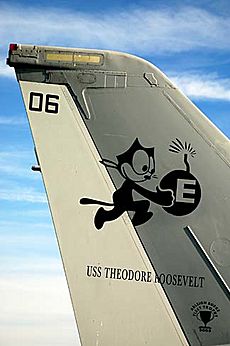
Because Felix was so popular and his name meant "happy," many people and groups used him as a mascot. One of the first was a car dealer in Los Angeles named Winslow B. Felix. His neon sign with Felix's smiling face is still a famous landmark in LA. The 1922 New York Yankees baseball team also adopted Felix. Pilot Ruth Elder took a Felix doll with her when she tried to fly across the Atlantic Ocean.
Felix's popularity continued. In the late 1920s, a U.S. Navy bombing squadron used Felix carrying a bomb as their symbol. This symbol is still used today by the VFA-31 squadron, nicknamed the "Tomcatters." Felix appears on their jacket patches and aircraft.
Felix is also the oldest high school mascot in Indiana. He was chosen in 1926 after a Logansport High School basketball player brought his Felix toy to a game. When the team won, Felix became their mascot.
In 1928, when television was new, the very first image ever seen on TV was a Felix the Cat toy. It was used as a test pattern for hours by engineers.
Even almost 100 years after his first appearance, Felix still shows up in pop culture. The pop punk band The Queers use Felix as their mascot. He's often drawn in a punk style, scowling or playing guitar. Felix was almost in the 1988 movie Who Framed Roger Rabbit, but the rights couldn't be obtained. However, he does appear on the entrance to ToonTown in the movie. For Felix the Cat's 100th anniversary, Universal Pictures declared November 9 "Felix the Cat Day." They released new merchandise like Pop! figures, Skechers shoes, and PEZ dispensers.
Felix in Comics
| Felix the Cat | |
|---|---|

An ink drawing of Felix by Otto Messmer dating from around 1975.
|
|
| Author(s) | Pat Sullivan Otto Messmer (1927–1954) Jack Mendelsohn (1948–1952) Joe Oriolo (1955–1966) |
| Current status/schedule | Daily and Sunday, concluded |
| Launch date | 19 August 1923 |
| End date | 1966 |
| Syndicate(s) | King Features Syndicate |
| Publisher(s) | Dell Comics |
| Genre(s) | Humor, funny animal |
Pat Sullivan started a syndicated comic strip for Felix on August 19, 1923. In 1927, Messmer took over drawing the strip. Messmer continued drawing the Sunday Felix comic strips until 1943. Then, he wrote and drew Felix comic books for Dell Comics for eleven years. Jack Mendelsohn also wrote the Felix strip from 1948 to 1952. In 1954, Messmer retired from the daily newspaper strips, and his assistant Joe Oriolo took over. The strip ended in 1966. Felix also appeared with Betty Boop in a comic strip from 1984 to 1987.
From Silent Films to Sound
When synchronized sound came to movies with The Jazz Singer in 1927, the company distributing Felix films urged Pat Sullivan to make "talkie" cartoons. But Sullivan refused. This led to problems between them. Only after other studios released sound cartoons, like Disney's Steamboat Willie, did Sullivan see the potential. He signed a contract with First National Pictures in 1928, but it didn't last. So, Sullivan found Copley Pictures to distribute his new sound Felix cartoons. In October 1929, an ad showed Felix saying, "You ain't heard nothin' yet!"
Felix's move to sound was difficult. Sullivan didn't prepare well and added sound effects after the animation was done. The results were not good. Disney's Mickey Mouse seemed to be taking audiences away from Felix. Even new sound cartoons couldn't bring back Felix's audience. Copley Pictures canceled Sullivan's contract. Sullivan planned to start a new studio, but it never happened. Things got worse when Sullivan's wife died in 1932. Sullivan became depressed, and his health declined. He died in 1933. Messmer later said that Sullivan left everything in a mess, and he couldn't continue the character because he didn't own the rights.
In 1935, Amadee J. Van Beuren asked Messmer if he could bring Felix back to the screen. Van Beuren offered Messmer a full staff and resources. But Messmer declined and suggested Burt Gillett, a former Sullivan employee. So, in 1936, Van Beuren got permission to make new Felix shorts in color and with sound. Gillett changed Felix's personality, making him a more common funny animal character. The new shorts were not successful, and after only three films, Van Beuren stopped the series.
Felix's Revival
In 1953, Official Films bought the old Felix shorts. They added sound to them and sold them for home movies and TV.
Otto Messmer's assistant, Joe Oriolo, who was drawing the Felix comic strip, made a deal to create a new series of Felix cartoons for television. Oriolo made 260 TV cartoons, which started in 1958. Like the Van Beuren studio before, Oriolo made Felix more friendly and focused on children. He introduced Felix's Magic Bag of Tricks, which could change into anything Felix wanted. The show also introduced many new characters.
Oriolo's stories often involved bad guys trying to steal Felix's Magic Bag. Sometimes, these bad guys were also Felix's friends. The cartoons were popular, but some critics felt they weren't as good as the older ones. This was partly because they used Limited animation (due to budget limits) and had simpler stories.
In 1970, Oriolo gained full control of the Felix character. In the late 1980s, after his father's death, Don Oriolo worked with animators to make Felix's first movie, Felix the Cat: The Movie. In the film, Felix visits another world with the Professor and Poindexter. The movie was released directly to video in 1991 and didn't get good reviews.
In 1994, Felix appeared on TV again in The Twisted Tales of Felix the Cat. Baby Felix followed in 2000 for the Japanese market, and also the direct-to-video Felix the Cat Saves Christmas. Oriolo also brought out many new Felix products, including Wendy's Kids Meal toys and a video game for the Nintendo Entertainment System.
In 2004, Felix was voted among the 100 Greatest Cartoons by a British TV channel, ranking at No. 89. According to Don Oriolo's blog, there were plans for a new TV series in 2008. This series, called The Felix the Cat Show, was planned to use computer graphics. In December 2020, Wildbrain began working on a new Felix the Cat series.
Home Video Releases
You can find Felix cartoons on DVD. Some releases include Presenting Felix the Cat and Felix the Cat: The Collector's Edition. Some of the 1958–1959 TV series cartoons were released on DVD by Classic Media. Parts of the 1990s series have also been released.
Filmography
Images for kids
See also
 In Spanish: El gato Félix para niños
In Spanish: El gato Félix para niños


